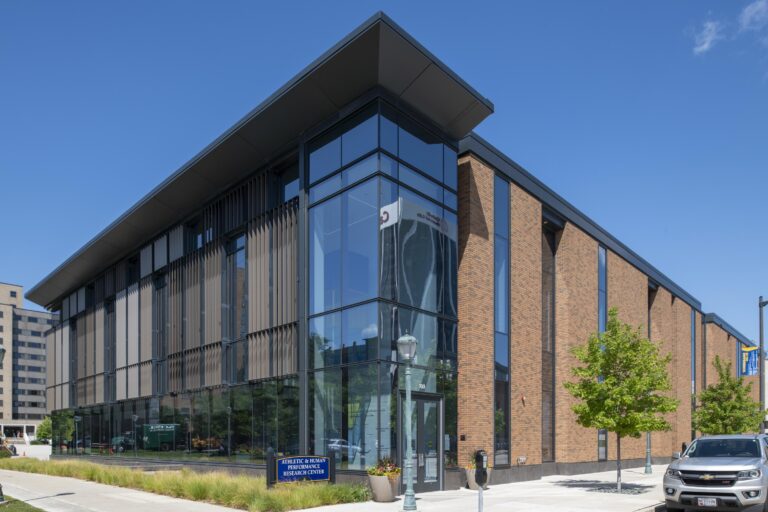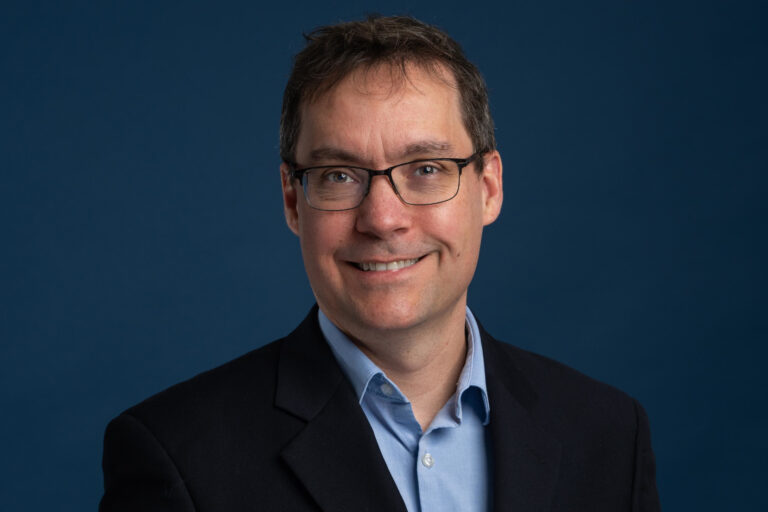Dr. Murray Blackmore is employing precise combinations of genes to stimulate growth in spinal axons with aims of re-establishing severed connections and restoring a range of functions.

By Jennifer Walter, photos by Kat Schleicher
Thousands of tiny green dots speckle the dimensional blob glowing on Dr. Murray Blackmore’s computer screen. It’s a map of a mouse’s brain, and each of the dots represents a single cell connected to the animal’s injured spinal cord.
Compared with a healthy specimen, the dots are sparse across many sections of the brain. Fewer connections mean the animal has less command over its physical abilities. Simple tasks like motor control and breath regulation might be compromised. After a spinal cord injury, these effects are common in humans too, leaving researchers hungry to understand the intricacies of how the brain disconnects from the body.
Blackmore, professor of biomedical sciences, created these brain maps as part of a collaborative project published in 2022 by scientists at Marquette and the University of Miami. With support from one of two grants from the National Institutes of Health that underwrite major projects in Blackmore’s lab — collectively more than $5 million in funding from NIH’s top R01 funding tier — the researchers have investigated how spinal cord injuries of varying severity wipe out brain-body connections in mice. They also tested treatments to restore these connections — vital information that will inform future treatments for human patients.
This project is the latest installment for Blackmore’s lab, which has been on the cutting edge of spinal cord research since its inception in 2011.
Up to half a million people experience a spinal cord injury every year. Even as the body heals, some of the damage is considered irreversible. That’s due to the reluctance of axons — the fibrous portions of neurons that transmit electrical signals from the brain to the body — to regenerate after injury.
Over the years, Blackmore’s lab has made numerous strides in understanding which genes are associated with axon growth and how they might be harnessed to stimulate the revival of brain-body connections in animals. In lab tests, the team has been focused on therapies that employ viruses to carry reparative genes to damaged neurons.
Some treatments tested in the lab have stopped axons from further degrading, while others have coaxed them to steadily grow back. In petri dishes and mouse models, the team has witnessed the very beginnings of gene therapies that could one day carry over into treatments for humans.
The progress has been gradual, but it’s provided vital information to the field of neuroscience. And in recent years, Blackmore explains, the lab has taken a more holistic approach toward understanding the underlying mechanisms of spinal cord injury.
While paralysis is a common outcome for the injured, Blackmore explains that patients have to deal with a lot more than just loss of motion. “There’s bladder control, bowel control, blood pressure control, temperature control, posture. There are all kinds of regulation of sensation,” he says.
It’s because of the multifaceted outcomes of spinal cord damage that Blackmore’s lab began to take what he calls a “whole-brain approach” to understanding how these life-changing injuries affect a range of bodily functions. Over the past few years, the lab has shifted from being laser-focused on learning how to restore motor control in paralyzed patients in favor of a more holistic outlook.
Dr. Murray Blackmore builds holistically on his breakthrough: using viral gene delivery to spur growth of damaged axons.

Working with injured animals, for example, gave researchers the opportunity to test how to target certain regions of the spinal cord with treatments that can restore specific brain-body connections. In one experiment, they tested a gene treatment on rats with optic nerve injuries and watched as axons regenerated to reconnect the animal’s eye to its brain.
“For the first time, we’re getting information about how the reconnections are happening to the whole brain,” Blackmore says, instead of just focusing on regions that control walking and movement.
But some of the big research questions Blackmore and colleagues are tackling have remained the same since the lab’s founding. Figuring out how to regenerate axons is still a main focus. That includes searching for genes that might be able to stimulate axon growth. Embryonic nervous systems have no problem growing axons back; the challenge is to translate that to adult patients.
One novel approach that the lab explored a few years ago investigated whether team members could turn on genes associated with cancer growth — which notoriously proliferates out of control — to stimulate axon growth.
After probing that connection for a few years, Blackmore says they realized genes that could influence cancer cells were almost always active in nerve cells, too. “It turned out to be so true that it’s not even useful,” he says.
The approach didn’t help them discover a treasure trove of new solutions for axon growth. But it did help them develop a broader philosophy for finding promising gene candidates.
“We’re now convinced that there’s not going to be one gene, there’s going to be a set of interacting genes that need to be supplied as a group” to stimulate the regeneration of axons, Blackmore explains. “The name of the game is not just finding genes that are relevant for growth. It’s finding the set of synergizing genes.”
Though Blackmore’s lab still has a needle-like focus on the cutting-edge science of axon regeneration, the holistic approach he’s taken to understand the mechanisms of spinal cord injuries — and how to heal them — has permeated just about every part of the lab’s daily routines.
One recent development: Blackmore brought on a new lab member in 2020 with a spinal cord injury to weigh in on the research direction at weekly meetings. Nancy Nicholas, a retired Boeing executive who worked in manufacturing research and development, serves as a community representative, a sounding board helping to guide ideas based on her lived experience.
“As we think about the questions that we want to go after, we’ve got someone in the room who can weigh in at that really early idea formulation stage,” Blackmore says. So, as the lab focuses on the smallest facets of the human body, its ultimate goal is to improve the quality of life for those living with spinal cord injuries. Even if solutions are still years away, every incremental step takes Blackmore and other spinal cord researchers another step toward healing.
Read the other two parts in this series focusing on Dr. Kristi Streeter’s lab here and the Neuro Recovery Clinic here.


